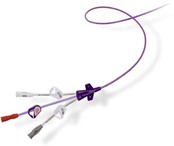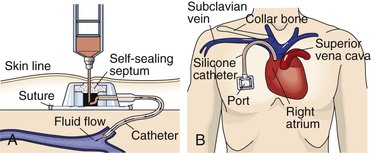Skill 12
Central Venous Access Device Care
Central Venous Catheter, Ports
A central vascular access device (CVAD) differs from short peripheral or midline catheters in relation to the final catheter tip location. A CVAD has a final tip location in the junction of the right atrium (Fig. 12-1). The final tip placement of CVADs inserted in the femoral region should be in the inferior vena cava above the level of the diaphragm.
Valve-tipped devices are those in which the tip is configured with a three-way pressure-activated valve (e.g., Groshong) or the hub of the device has a pressure-activated valve, which reduces the risk for hemorrhage, air embolism, and occlusion. CVADs can have single or multiple lumens (Fig. 12-2). With the exception of the implanted venous port, each of these devices is accessed using the hub, which is located on the end of each of the external lumen(s).

Fig. 12-2 Peripherally inserted central catheter (PICC) showing three access ports to individual lumens. (Courtesy and copyright © Bard Access Systems.)
Implanted venous ports are located within the reservoir pocket. To use the implanted venous port, the septum is palpated and a special noncoring needle is inserted through the skin into a self-sealing injection port (Fig. 12-3).

Fig. 12-3 A, Cross section of implantable port showing access of the port with noncoring needle. B, Implanted port and catheter.
Primary complications associated with CVADs are usually related to central line–associated bloodstream infections (CLABSIs) (Alexander et al., 2009). The Institute for Healthcare Improvement (IHI) Central Line Bundle is a group of evidence-based interventions for patients with intravascular central catheters (IHI, 2011). The key components of the IHI Central Line Bundle are: hand hygiene, maximal barrier precautions upon insertion, chlorhexidine skin antisepsis, optimal catheter site selection with avoidance of the femoral vein for central venous access in adult patients, and daily review of line necessity with prompt removal of unnecessary lines
Delegation Considerations
The skill of caring for a CVAD cannot be delegated to nursing assistive personnel (NAP). Delegation to licensed practical nurses (LPNs) varies by state Nurse Practice Act. The nurse instructs the NAP to:
▪ Report the following to the nurse immediately: patient’s dressing becomes damp or soiled, catheter line appears to be pulled out farther than original insertion position, IV line becomes disconnected, patient has a fever, patient complains of pain at the site.
Equipment
Site Care and Dressing Change
Blood Sampling
▪ Antimicrobial swabs (e.g., 2% chlorhexidine, alcohol)
▪ Vacutainer system or blood transfer device (see agency policy)
▪ Preservative-free saline flush (0.9% normal saline solution [NSS])
▪ Blood tubes, including waste tubes, labels
▪ Syringe (5 mL or 10 mL; see agency policy) for discarded blood
▪ 10-mL syringe with 5 to 10 mL saline flush
Stay updated, free articles. Join our Telegram channel

Full access? Get Clinical Tree



